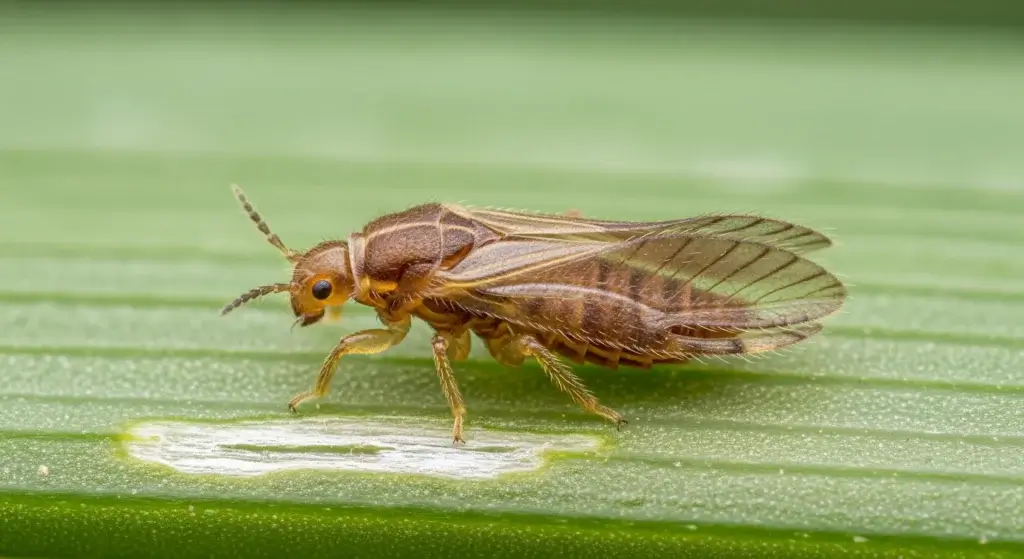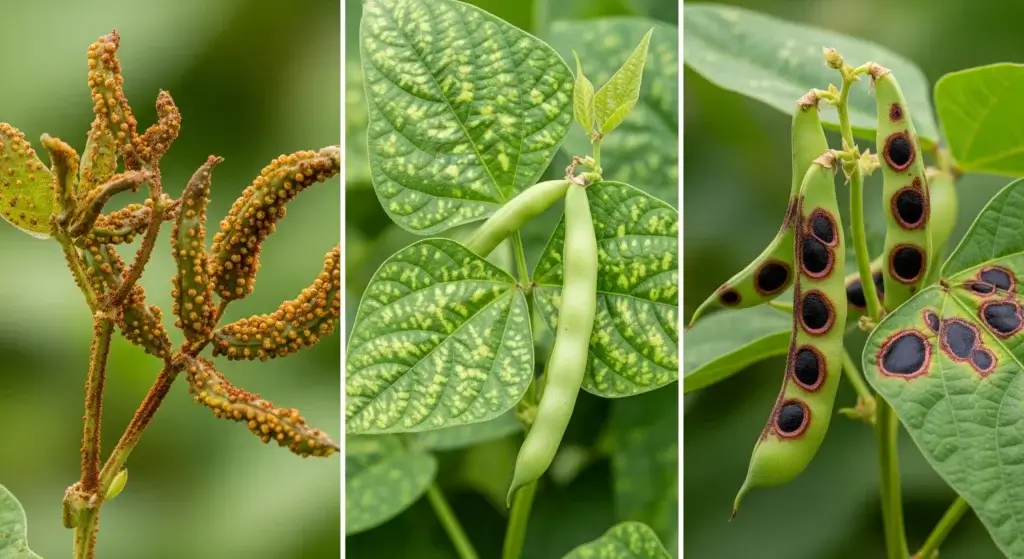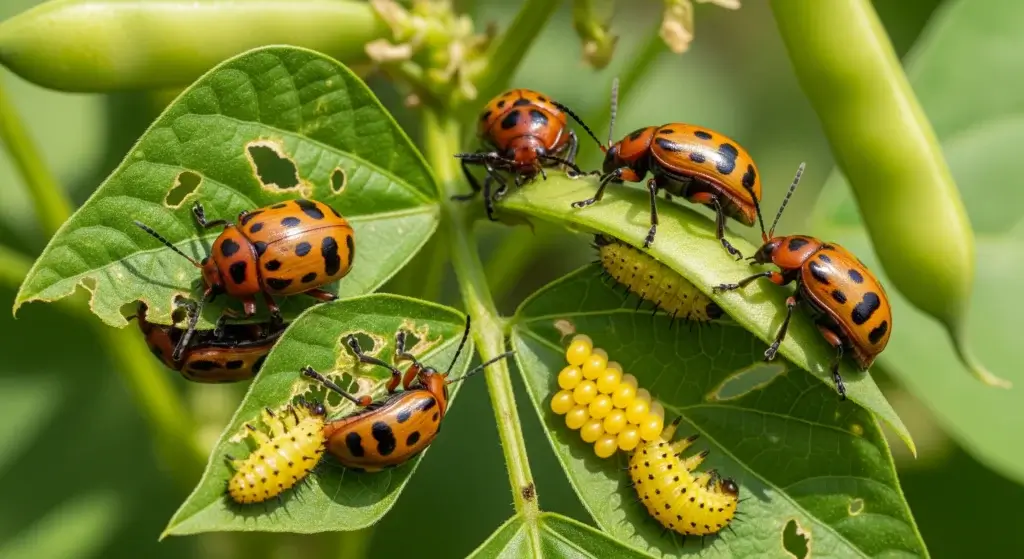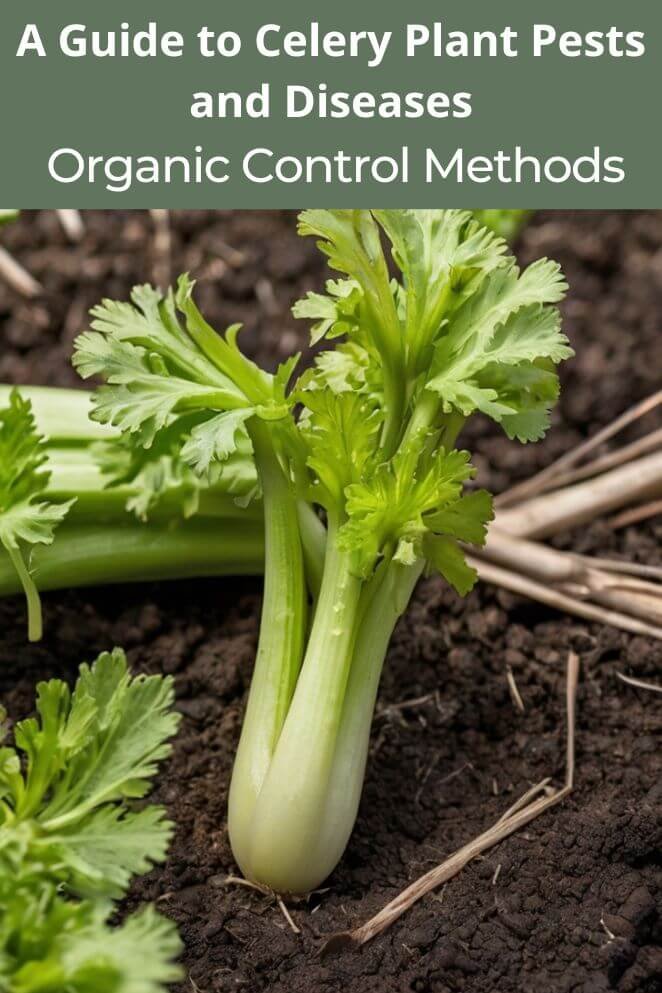
Want crisp, tasty celery that’s more superhero than snack attack?
Growing celery can be super satisfying—if you keep pesky pests and nasty diseases at bay.
These troublemakers love to mess with your crunchy stalks and delicate flavor, but don’t worry—I’ve got your back.
This quick guide breaks down the usual celery villains and how to spot, stop, and zap them before they crash your celery party.
Let’s keep those stalks strong and your garden thriving all season long!
Understanding Celery Plant Vulnerabilities
Celery’s a bit of a diva in the garden—long growing season, thirsty as a marathon runner, and with delicate stalks that pests and diseases just love to mess with.
That means keeping your celery healthy takes some serious detective work and quick moves.
The secret? Know your enemy.
Learn the habits of those pesky bugs and the conditions that let diseases crash your celery party.
With a mix of smart prevention and spot-on treatments, you’ll keep your celery thriving like a pro—no drama, just crisp stalks and tasty rewards.
Think of it as gardening with a game plan, not just winging it!
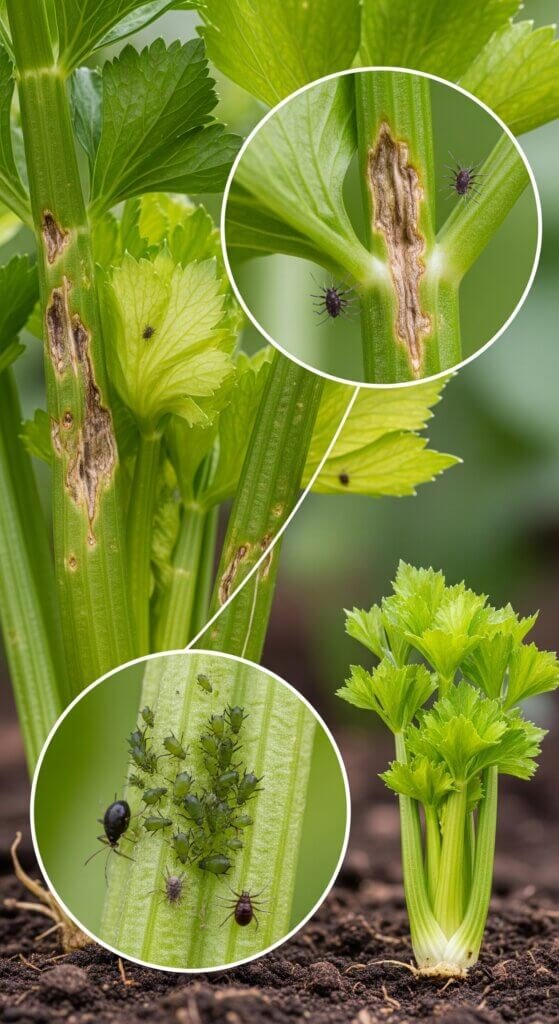
Major Celery Plant Pests
Aphids
These little green (or black) troublemakers love to hang out on your celery’s new growth, sucking the life (and sap) right out.
They also leave behind sticky honeydew—think of it as their signature mess—which invites sooty mold and yellow, sad leaves.
Aphids multiply faster than your favorite streaming show drops episodes, so nip them in the bud!
Identification signs:
- Clusters of tiny green or black bugs on leaves and stems
- Sticky, shiny residue on your celery (ew)
- Yellowing, curling leaves and stunted growth
- Black mold growing on that sticky stuff
Control methods:
- Water spray treatment: Home gardeners can often get effective control by washing aphids with a strong stream of water.
- Insecticidal soap: Apply thoroughly to both leaf surfaces, may require multiple applications
- Neem oil: A vegetable oil derived from the neem tree, it’s a safe, easy-to-find and affordable spray that helps to smother not only aphids, but cabbage worms, ants, leafminers, and beetles as well.
- Beneficial insects: Introduce ladybugs, lacewings, and parasitic wasps as natural predators
Celery leaftier
This caterpillar spins webs to tie your leaves together and munches inside like a tiny bandit, making it tough to spot until damage is done.
It loves celery but also crashes the beet and spinach parties.
Identification signs:
- Leaves tied up in silken webs (not your kid’s Halloween decoration!)
- Ragged holes and skeletonized leaves
- Small green caterpillars hiding inside leaf folds
- Less leaf surface means less photosynthesis = sad celery
Control strategies:
- Bacillus thuringiensis (Bt): Small larvae can be controlled with Bt products, but larger larvae may be more difficult to control.
- Pyrethrum applications: For organic growers, a double whammy of pyrethrum sprays: first to flush them out, second to finish the job
- Manual removal: Hand-pick visible caterpillars and destroy affected leaves
- Row covers: Use during vulnerable growth stages to prevent adult moths from laying eggs
Cutworms
These sneaky caterpillars strike under the cover of darkness, snipping young celery stems at the base like miniature garden ninjas.
One night and your seedling might be down for the count.
Identification signs:
- Plants suddenly topple over at soil level—no obvious culprit in sight
- Find fat, C-shaped caterpillars lurking in the soil during the day
- Irregular munch marks on lower stems
Prevention and control:
- Physical barriers: Create cardboard or aluminum foil collars around transplants
- Soil cultivation: Control cutworms early in the season by handpicking, trapping, or exposing them to predators such as birds.
- Beneficial nematodes: Apply to soil to target cutworm larvae
- Evening inspections: Hand-pick caterpillars during their active feeding period
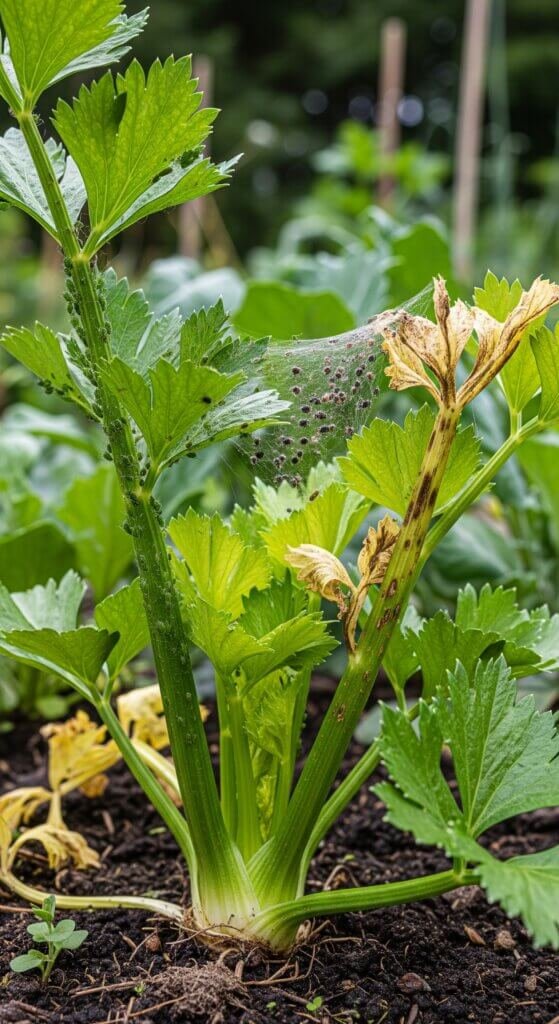
Common Celery Plant Diseases
Late blight (septoria leaf spot)
This fungal troublemaker, Septoria apicola, loves warm, humid weather and spreads like gossip at a high school reunion—fast and messy.
It’s the #1 disease to watch out for in celery, turning your lush leaves into a yellow, spotty mess.
Symptom:
- Tiny round spots that look oily (not the spa treatment you want) on older leaves
- Yellow halos like mini solar flares around dark spots
- Leaves turn yellow and die off early, leaving your plant looking like it’s had a rough night
- Your celery’s vigor and harvest take a nosedive
Management approach:
- Cultural controls: Keep the garden clean and free of weeds. Remove infected plants.
- Resistant varieties: Plant resistant varieties: Emerson Pascal, Utah 52-75.
- Fungicide applications: Apply copper-based fungicides preventively during favorable weather conditions
- Crop rotation: Avoid planting celery in the same location for consecutive seasons
Celery anthracnose (leaf curl disease)
Nobody’s quite sure how this disease sneaks in, but seeds might be the culprits—kind of like that unexpected plus-one at a party.
It’s notorious for messing up greenhouse starts and can wreck your celery’s vibe if left unchecked.
Characteristics:
- Leaves curl like they’re trying to do the worm
- Dark, sunken spots show up on stems and leaf stalks
- Leaves drop early like bad habits
- Plants get stunted and yields drop
Control Strategies:
- Seed treatment: Use certified, disease-free seeds
- Sanitation: The pathogen is easily spread in the field by water and splashing soil. Minimize splash irrigation and soil disturbance
- Weed management: Once on the farm, celery anthracnose fungi can infect several weeds. Common lambsquarters, redroot pigweed, and other hosts should be eliminated
- Preventive fungicides: Apply protective sprays during periods of high disease pressure
Fusarium yellows
This fungal villain lives in your soil like a bad roommate who refuses to leave.
It attacks the plant’s vascular system, turning leaves yellow and wilting your celery faster than you can say “garden drama.”
Symptom:
- Odd-shaped yellow spots on leaves and stalks that brown over time
- Dark streaks inside stems (like celery veins with bad circulation)
- Yellowing starts low and climbs up the plant
- Plants wilt even if you’re watering like a pro
- Severe cases can kill your crop
How to fight back:
- Sanitize your tools like a germaphobe before moving around your garden
- Plant celery in clean, pathogen-free soil (kick the freeloaders out)
- Choose resistant or tolerant celery varieties—your plant’s personal bodyguards
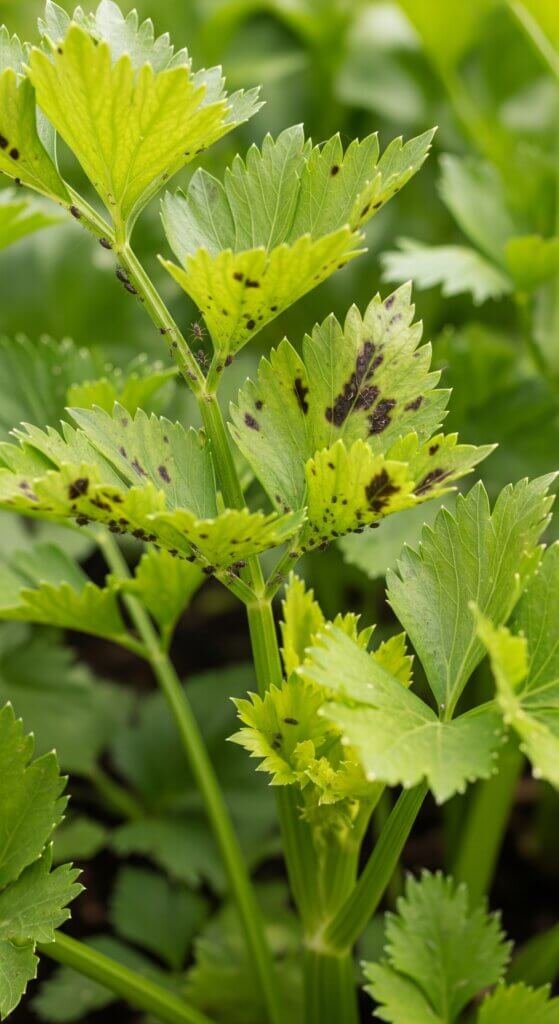
Integrated Pest and Disease Management
Prevention-first approach
Think of pest and disease management like setting up a Jedi defense for your celery—create an environment where villains can’t even land, so you avoid constant battles later on.
A healthy celery plant is like a superhero: strong, resilient, and less tempting to pests.
Site selection and preparation:
- Pick a spot with great drainage and good airflow—celery hates soggy feet and stuffy rooms.
- Give your plants some personal space to breathe and avoid gossip (aka disease spread).
- Rotate your crops yearly—don’t let pests RSVP to the same party twice.
- Keep soil pH between 6.0 and 7.0—the sweet spot where celery feels like royalty.
Cultural practices:
- Use only certified, disease-free seeds and transplants—no shady characters allowed.
- Keep soil evenly moist, but don’t drown your green friends.
- Mulch it up to stop weeds from crashing the party and reduce messy soil splashes.
- Clear out dead plant parts pronto; no one wants a creepy hangout for pests over winter.
Monitoring and early detection
Regular check-ins let you catch troublemakers early, before they turn your garden into a soap opera.
Think of yourself as a plant detective—inspect weekly, take notes, and stay ahead of the drama.
Weekly inspection:
- Hunt for any pests or munch marks on leaves.
- Look for disease signs like spots, curls, or wilting.
- Track weather—warm and humid? Time to be extra vigilant.
- Jot down what you see so you can spot patterns and tweak your game plan.
Key monitoring tools:
- A hand lens to zoom in on tiny pests (because size doesn’t matter, but details do).
- Yellow sticky traps to catch those sneaky flying bugs.
- Soil thermometer to predict when diseases might throw a tantrum.
- Weather updates to time your treatments perfectly—because timing is everything.
Organic treatment options
Want to keep things natural and green?
Organic gardening has some seriously cool tricks to keep pests and diseases in check—think of them as your plant’s bodyguards and secret agents.
Biological controls:
- Beneficial Insects: Encourage natural predators through diverse plantings
- Microbial Pesticides: Use Bt-based products for caterpillar control
- Beneficial Nematodes: Apply for soil-dwelling pest management
- Companion Planting: Grow pest-deterrent plants nearby
Organic sprays and pplications:
- Neem Oil: Multipurpose treatment for various pests and diseases
- Insecticidal Soap: Effective against soft-bodied insects
- Copper Fungicides: Preventive treatment for fungal diseases
- Essential Oil Sprays: Natural repellents for various pests
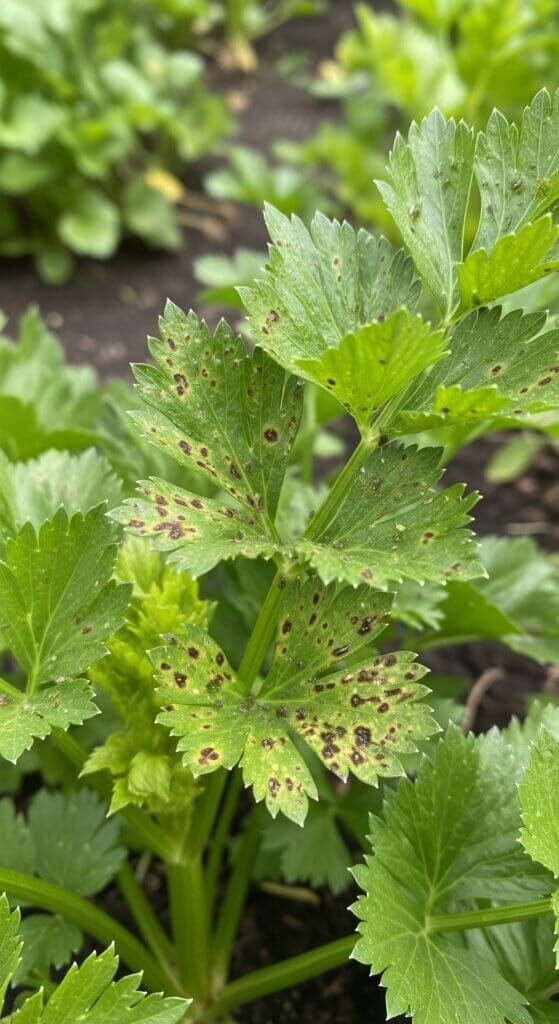
Seasonal Management Calendar
Spring Preparation (March-April)
- Prepare planting beds with proper drainage
- Start seeds indoors under controlled conditions
- Apply beneficial nematodes to soil before planting
- Install row covers and physical barriers
Early Summer Management (May-June)
- Transplant seedlings after hardening off
- Begin weekly monitoring for pests and diseases
- Apply preventive fungicide treatments if weather conditions warrant
- Establish beneficial insect habitat
Mid-Season Care (July-August)
- Intensify monitoring during peak pest activity
- Apply targeted treatments as needed
- Maintain consistent irrigation to reduce plant stress
- Remove diseased plant material promptly
Late Season and Harvest (September-October)
- Continue pest monitoring through harvest
- Clean up garden debris to eliminate overwintering sites
- Plan crop rotation for following season
- Evaluate season performance for future improvements
Conclusion: Building Resilient Celery Gardens
Growing celery isn’t just about watering and hoping for the best—it’s like training a tiny green superhero.
Beat pests and diseases with a combo of prevention, smart monitoring, and spot-on treatments.
Think of it as giving your celery a personal bodyguard squad: healthy soil, good spacing, and beneficial bugs all working together.
Remember, this is a season-long mission—stay sharp, act fast, and your celery will reward you with crunchy, tasty stalks worthy of a salad victory dance.
Start today, and watch your celery thrive like it’s got the ultimate cheat code!

